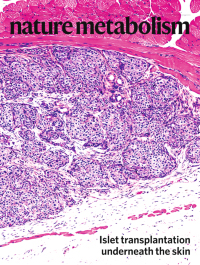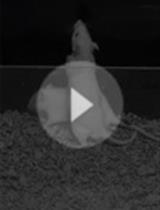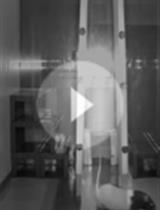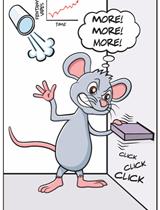- EN - English
- CN - 中文
Construction of Activity-based Anorexia Mouse Models
基于活动的厌食小鼠模型的构建
(*contributed equally to this work) 发布: 2023年08月05日第13卷第15期 DOI: 10.21769/BioProtoc.4730 浏览次数: 1608
评审: Pilar Villacampa AlcubierreAnonymous reviewer(s)
Abstract
Anorexia nervosa (AN) is a psychiatric disorder mainly characterized by extreme hypophagia, severe body weight loss, hyperactivity, and hypothermia. Currently, AN has the highest mortality rate among psychiatric illnesses. Despite decades of research, there is no effective cure for AN nor is there a clear understanding of its etiology. Since a complex interaction between genetic, environmental, social, and cultural factors underlines this disorder, the development of a suitable animal model has been difficult so far. Here, we present our protocol that couples a loss-of-function mouse model to the activity-based anorexia model (ABA), which involves self-imposed starvation in response to exposure to food restriction and exercise. We provide insights into a neural circuit that drives survival in AN and, in contrast to previous protocols, propose a model that mimics the conditions that mainly promote AN in humans, such as increased incidence during adolescence, onset preceded by negative energy balance, and increased compulsive exercise. This protocol will be useful for future studies that aim to identify neuronal populations or brain circuits that promote the onset or long-term maintenance of this devastating eating disorder.
Keywords: Anorexia nervosa (AN) (神经性厌食症(AN))Background
Anorexia nervosa (AN) is a severe psychiatric disorder characterized by extreme hypophagia, severe body weight loss, distorted self-image, and maladaptive food choices (Mitchell and Peterson, 2020). The onset of AN usually occurs in adolescence or young adulthood (Favaro et al., 2009) and it mainly affects females (roughly 92%) (Udo and Grilo, 2018). It has the highest mortality rate among psychiatric disorders (Treasure et al., 2015), 12 times higher than the death rate associated with all causes of death for females 15–24 years old (Smink et al., 2013; Fichter and Quadflieg, 2016). Currently, there are no effective pharmacological cures for AN (Crow, 2019). To inform new therapies and to identify individuals at risk for the disorder, a deeper understanding of the neurobiology underlying AN is urgently needed. The etiology of AN is complex since it involves interactions between genetic, environmental, social, and cultural factors. Such complexity has made it difficult to develop an appropriate animal model so far (Siegfried et al., 2003). Previous studies have used approaches involving genetic, environmental, and/or dietary manipulations to study AN in animal models. Genetically modified mouse models have been used to ablate or activate specific neuronal populations, with immediate reduction of food intake (Luquet et al., 2005; Calvez et al., 2011). While most of these studies might provide insights into neural circuits causing anorexia (simply seen as the loss of appetite for food), their translatability to humans is minimal since the nature and timing of the stressors are different from those that increase the risk of developing AN in humans (François et al., 2022).
The best characterized animal model of AN is the activity-based anorexia model (ABA) (Klenotich and Dulawa, 2012). This is a bio-behavioral phenomenon described in rodents that models the key symptoms of AN (self-induced starvation and compulsive running, to list a few of them) and is based on the principle that mice will prefer to run instead of eating even when food is available, if previously exposed to food restriction. The ABA, however, cannot capture the sociocultural factors that might promote AN.
Here, we propose a method to couple a genetically modified mouse model to a specific ABA protocol designed for adolescent female and male mice. We chose to investigate the involvement of the hypothalamic agouti-related peptide and neuropeptide Y (AgRP/NPY)-expressing neurons. These neurons are physiologically active during fasting, but also modulate complex non-feeding behaviors (Dietrich et al., 2015). To impair AgRP neuron function, we studied AgRP neuron-specific diphtheria toxin receptor-expressing mice (AgRP-DTR), which allow ablation of AgRP neurons early postnatally by administering diphtheria toxin at P5 (Luquet et al., 2005). By combining ABA with a transgenic mouse model and further choosing a critical time window (adolescence), it is feasible to get insights into genetic × environmental factors (such as early life stress) that contribute to the onset or propagation of AN. This protocol will be useful for future studies that aim to identify the contribution of specific neuronal populations to AN symptomatology. Combining the two approaches in adolescent mice will also allow the unraveling of mechanisms that contribute to resilience or vulnerability to AN.
Materials and reagents
Mouse cages (Tecniplast, catalog number: GM500)
Wire bar lids (Tecniplast, catalog number: GM500)
Bedding, Teklab corncob bedding (Envigo, catalog number: 7092)
Standard rodent diet, Teklab global 18% protein rodent diet (Envigo, catalog number: 2018S)
Paper towels
4-week-old female and male mice, Agouti-related protein mice (AgRP-DTR mice)
70% ethanol (VWR Chemicals, catalog number: 20842.298, to be dissolved in water to final concentration)
NaCl powder (Sigma, catalog number: 7647-14-5)
Diphtheria toxin (List Biological, catalog number: 150)
Equipment
In-cage running wheel (Starr Life Science Corporation, USA)
Infrared sensor for running wheel (Starr Life Science Corporation, USA)
Standard Windows PC (operating system Windows 7 or later)
DataPort1224 (DP1224) (Starr Life Science, USA)
Powered USB hub (Conrad Electronic AG, Digitus DA-70229 10 Port USB 2.0-Hub/catalog number:1027267-5k) (to provide sufficient USB ports and equipment spacing flexibility, one USB port support for each DP1224s)
Analytical balance (1 mg) (MettlerToledo, Balance XPE206DR, catalog number: 30132913)
Compact scale (0.1 g) (Haslab, HCB 302 Highland portable precision, catalog number: 105654302)
Red headlamp (Energizer, online vendor)
Software
VitalView Data Acquisition System software version 5.1 (Starr Life Science, USA https://www.starrlifesciences.com/product/activity-software/)
GraphPad Prism version 9 (GraphPad software, San Diego, CA, https://www.graphpad.com)
Note: Do not run other software on your Windows PC while VitalView is acquiring data.
Procedure
文章信息
版权信息
© 2023 The Author(s); This is an open access article under the CC BY-NC license (https://creativecommons.org/licenses/by-nc/4.0/).
如何引用
Miletta, M. C. and Horvath, T. L. (2023). Construction of Activity-based Anorexia Mouse Models. Bio-protocol 13(15): e4730. DOI: 10.21769/BioProtoc.4730.
分类
神经科学 > 行为神经科学 > 实验动物模型 > 小鼠
医学 > 神经性厌食症 > 小鼠模型
您对这篇实验方法有问题吗?
在此处发布您的问题,我们将邀请本文作者来回答。同时,我们会将您的问题发布到Bio-protocol Exchange,以便寻求社区成员的帮助。
提问指南
+ 问题描述
写下详细的问题描述,包括所有有助于他人回答您问题的信息(例如实验过程、条件和相关图像等)。
Share
Bluesky
X
Copy link












